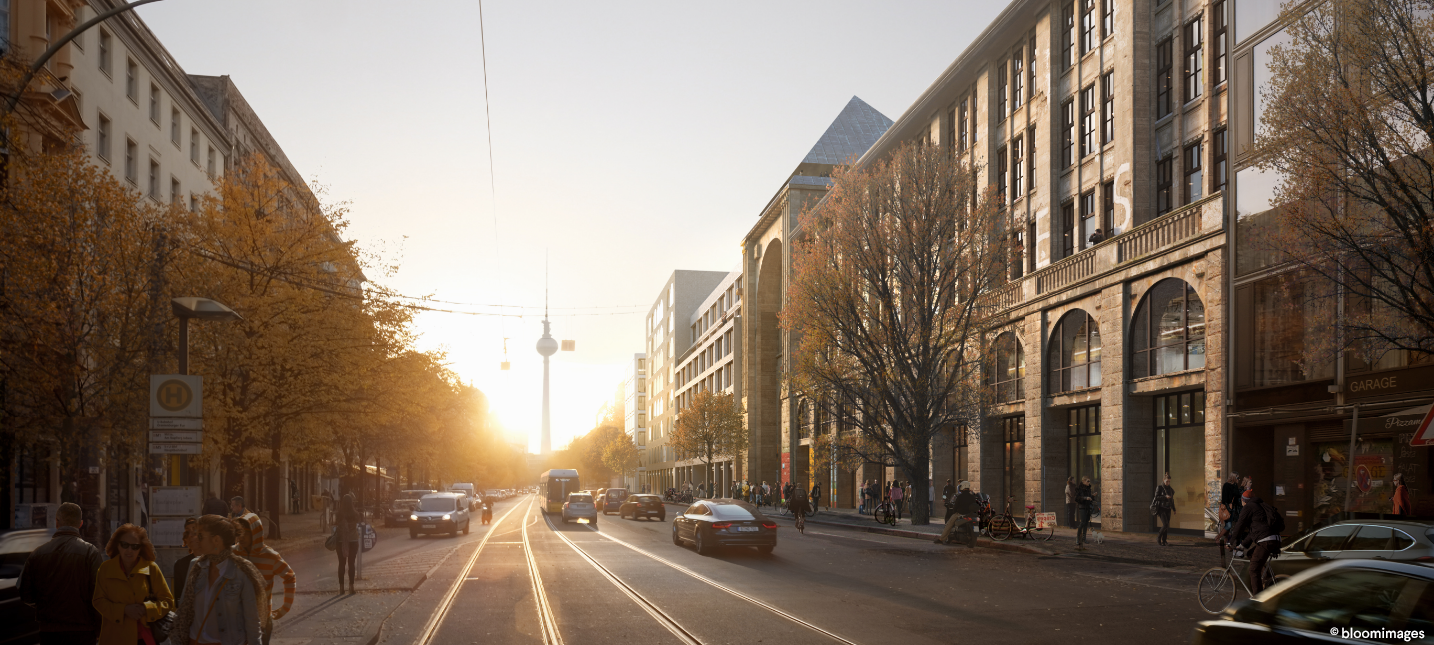The new Spandauer Vorstadt: City quarter Am Tacheles soon completed

Nur einen Steinwurf von den Hackeschen Höfen entfernt entsteht das Stadtquartier Am Tacheles. Mitte 2023 sollen Büros und Wohnungen bezogen werden sowie Geschäfte und ein Museum eröffnen.
Berlin's largest inner-city development area is nearing completion: the new urban quarter at Tacheles. Anyone out and about between Oranienburgerstraße, Friedrichstraße and Johannisstraße in recent years has been able to witness how the terrain, and with it the entire area, was being fundamentally transformed. The more than 25,000-square-meter wasteland around the so-called Kunsthaus Tacheles had become a gigantic construction site, all phases of which are to be completed by mid-2023.
Like the entire Spandauer Vorstadt, the area is steeped in history. Before World War I, Oranienburger Straße was not only home to classic Berlin apartment buildings, but also Europe's first shopping mall based on the American model – the Friedrichstraße Passage. Here, from 1907 onwards, there were some visionary services. Mechanical conveyor belts and a multitude of messengers ensured that freshly purchased goods were shipped so quickly that they usually arrived at home before the buyer did.
After the First World War, the Passage became a "House of Technology," where the electrical company AEG exhibited its appliances. During the "Third Reich," Nazi organizations occupied the buildings. After the war, institutions such as a school for artists, a cinema and a dance school used the complex. In 1980 and 1982, parts of the area were torn down to make room for a new street. Finally, with the fall of the Wall, artists discovered the neglected Spandauer Vorstadt. As in the case of the Hackesche Höfe, they prevented the demolition of the ensemble by occupying it.
An icon for alternative ways of life and art
These years have long shaped the view of the area and the Spandauer Vorstadt. The Passage department store, known as Tacheles, stood for a different form of departure: The ruin became an icon for alternative forms of life and art. For many years, studios, clubs, bars, beer gardens and cinemas were located on the site. Everything always seemed quite trashy and that's exactly why it was so popular. And while the whole neighborhood was renovated and modernized in the years after the fall of the Wall, the old coal stoves were replaced and even bicycle lanes were built, the Tacheles and the surrounding area remained an alternative cultural location for a long time.
Image © bloomimages

800 million euros
In 1998, the Fundus Group acquired the property and planned a so-called Johannis-Quartier. Due to a lack of investors, the group sold the site to the U.S. bank Perella Weinberg in 2012. The bank has now invested 800 million euros to build a new mixed-use urban district on the site. The urban master plan was drawn up by the architectural firm Herzog & de Meuron.
Ten buildings with offices and condominiums are grouped around four courtyards, which are assigned to the areas of residential, retail, culture and work. Restaurants and retail businesses are to enliven the quarter: A range of enterprises from vegetarian snack bars to Michelin-starred restaurants, from local retailers to major international labels will move into the 48 retail units on the first floor, according to project developer pwr. In the basement, Rewe will open one of its largest supermarkets in Berlin.
Image © bloomimages

A bit of a reference to the past
The design is also expected to create a number of historical references: For example, the listed part of the Tacheles will be preserved – along with the graffiti. And the L-shape of the passage from Friedrichstraße to Oranienburger Straße picks up on the historical model from the pre-war period.
A large square opens up to Oranienburger Straße, lined with restaurants and stores. The whole quarter is also intended to be green and airy: 170 trees, currently growing in a tree nursery, will be planted in the squares. The roofs are also greened, and instead of roofing as in the historic arcades, green bridges at a lofty height bring the two courtyard sides together on the left and right.
Image © bloomimages

And to ensure that culture is not neglected, which after all shaped the location for 30 years, a private photography museum is to move into the former Kunsthaus: Fotografiska from Sweden operates branches in New York and Tallinn in addition to the museum in Stockholm. With its large exhibitions, the museum could actually become a crowd puller in Berlin. However, this no longer has much to do with the alternative cultural forms of past decades.